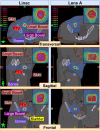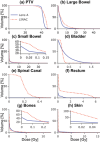Converging lens radiotherapy (CLRT) employing kilovoltage x-ray source: Treatment planning study
- PMID: 40781791
- PMCID: PMC12334860
- DOI: 10.1002/mp.18007
Converging lens radiotherapy (CLRT) employing kilovoltage x-ray source: Treatment planning study
Abstract
Background: Converging lens radiotherapy (CLRT) is a novel radiotherapy modality employing a lens which produces a nearly monoenergetic x-ray beam at 60 keV to focus radiation on deep-seated tumors, enabling highly precise dose delivery.
Purpose: This study represents the first comparison of CLRT treatment plan quality to conventional intensity-modulated radiation therapy (IMRT) and volumetric modulated arc therapy (VMAT). The goal is to provide a proof-of-concept of CLRT treatment planning and to evaluate whether CLRT could potentially offer improved organ-at-risk (OAR) sparing and target coverage.
Methods: The physical CLRT prototype system was developed by Convergent Radiotherapy and Radiosurgery Ltd. (CRnR) in Haifa, Israel, under the product name AngelCure. We initially characterized the CLRT beam model using Monte Carlo simulations, validating it with film dosimetry of the physical beam. Subsequently, we developed a 3D dose computation algorithm and novel inverse, non-coplanar treatment planning for CLRT inside the open-source radiation treatment planning platform matRad. Two prototype lenses with different focal spot sizes (A mm and B mm) were employed. Using these tools, we performed CLRT treatment plan optimization for selected treatment sites and compared our results retrospectively to conventional IMRT/VMAT patient plans from the Dana-Farber Brigham Cancer Center clinical database, which were generated in Eclipse (Varian Medical Systems, Palo Alto, CA, USA). Here, we present three cases from the central nervous system (CNS), thoracic, and genitourinary (GU) sites. We utilized conformity index (CI), target coverage index (TCI), conformal number (CN), and gradient index (GI) as plan quality metrics, together with dose-volume histogram points to compare OAR sparing.
Results: CLRT demonstrated variable OAR dose sparing. In the CNS case, both lenses showed better hypothalamus sparing, with 0% of the volume receiving 400 cGy or more compared to 91% for Linac. For the Thoracic case, Lens A achieved 0% of esophagus volume receiving more than 1000 cGy, versus 11% for Linac. In the GU case, Lens A delivered at least 400 cGy to 0% of rectum volume, compared to 17% with Linac. CLRT demonstrated potentially better or comparable plan quality metrics, with Lens A showing perfect conformity (CI = 1.00) in the CNS case and Lens B demonstrating the steepest dose gradient (GI = 240%/cm).
Conclusions: This study serves as a first proof-of-concept of the treatment capabilities of a novel CLRT x-ray system. The system demonstrated, in this limited set of plans, better OAR dose sparing compared to conventional Linac-based plans across 3 different anatomical sites, accompanied by similar, and possibly better, plan quality metrics (CI, TCI, CN, GI), while maintaining comparable target coverage.
Keywords: converging lens radiotherapy (CLRT); non‐coplanar kV x‐ray lens treatment planning; organ at risk (OAR) sparing.
© 2025 The Author(s). Medical Physics published by Wiley Periodicals LLC on behalf of American Association of Physicists in Medicine.
Conflict of interest statement
The authors have no relevant conflicts of interest to disclose.
Figures







References
-
- Hawkins PG, Kadam AS, Jackson WC, Eisbruch A. Organ‐sparing in radiotherapy for head‐and‐neck cancer: improving quality of life. Semin Radiat Oncol. 2018;28:46‐52. - PubMed
-
- Breitkreutz DY, Weil MD, Bazalova‐Carter M. External beam radiation therapy with kilovoltage x‐rays. Phys Med. 2020;79:103‐112. - PubMed
-
- O'Connell J, Weil MD, Bazalova‐Carter M. Non‐coplanar lung SABR treatments delivered with a gantry‐mounted x‐ray tube. Phys Med Biol. 2024;69:025002. - PubMed
MeSH terms
Grants and funding
LinkOut - more resources
Full Text Sources
Miscellaneous

